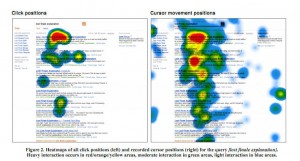New Technology Tracks the Eyepath of Website Visitors
A recently published research paper may prove to be of great interest to marketers. “No Clicks, No Problem: Using Cursor Movements to Understand and Improve Search,” by Jeff Huang, Information School University of Washington; and Ryen W. White and Susan Dumais of Microsoft Research, takes a look at the correlation of eyegaze on a webpage and cursor placement.
This research found a high correlation between where the cursor was placed on a page and where the user was actually looking, and created a tiny JavaScript capable of running invisibly on a webpage that tracks where the cursor is in real time providing information on where that webpage visitor is looking and, possibly more importantly, pausing throughout the visit.
This is from the abstract of the linked paper:
In this paper, we examine mouse cursor behavior on search engine results pages (SERPs), including not only clicks but also cursor movements and hovers over different page regions.
We: (i) report an eye-tracking study showing that cursor position is closely related to eye gaze, especially on SERPs; (ii) present a scalable approach to capture cursor movements, and an analysis of search result examination behavior evident in these large-scale cursor data; and (iii) describe two applications (estimating search result relevance and distinguishing good from bad abandonment) that demonstrate the value of capturing cursor data.
Maybe most intriguing for marketers is the final line of the abstract, “Our scalable cursor tracking method may also be useful in non-search settings.”
The JavaScript code that drives this online tracking tech is a mere 750 bytes and had a negligible effect on the load time of webpages hosting the script. Although this technology is not yet commercially available, it should eventually present another interesting avenue for marketers to test website visitor’s behavior.
Jeff Huang, the team member who implemented and deployed the cursor tracking code, mined the cursor data, and wrote parts of the paper, took a few moments to answer several questions I had about this intriguing technology.
Tell me a little more about this research.
Jeff Huang: We examined mouse cursor behavior on search engine results pages, including not only clicks but also cursor movements and hovers over different page regions. In an eye-tracking study, we showed that cursor position is closely related to eye gaze. We developed a scalable approach to capturing cursor movements, and an analysis of search result examination behavior for over 300,000 queries from around 22,000 people. Finally, we were able to use cursor movements to estimate search result relevance and distinguishing good from bad abandonment.
Marketers are probably familiar with click and heatmaps, and this seems closely related to that technology. Do you think this technology can be useful for more than search?
JH: Cursor movements can create heatmaps with a similar appeal as click maps. While click maps show only the regions being clicked, movement heatmaps can also show regions that received attention by proxy of the cursor position. Often clicks are not available for smaller sites so movements can provide richer information.
Could marketers utilize this tech for webpage research to improve, say, the eyepath of the page? Is cursor movement correlated with a page visitor’s eyepath?
JH: Yes, as we mention in the paper, the cursor is typically within 200 pixels of the eye gaze. The most common position for the cursor is to be slightly below what the user is looking at. We also found that the cursor follows the eye gaze by around 200ms [milliseconds] (although the data for this is highly variable).
Does this technology offer other applications for marketing efforts or webpage testing?
JH: Sure, having records of the cursor movements allow marketers to replay the user’s session on the Web page. For example, they can see which order a user filled out a form even if they did not complete the form and left the page instead. We have developed an efficient method to record the cursor movements so they take a minimal amount of space and can be collected without disrupting the user.
Is this tech publically available, and if not, when is commercial roll-out expected?
JH: This was developed as part of an internship at Microsoft Research last year, and deployed to internal users. I will return to Microsoft again this summer, but I cannot comment on its commercial availability.









